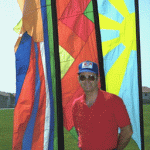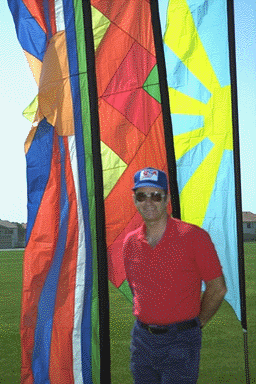 It has come to my attention that there is an interest in the history/evolution of stunt kiting as we know it today. So, here is my recollection of certain events and people since about 1982. This presentation will be in a question and answer format so that you the reader may make appropriate reference if you have additions, questions, or more accurate recollection.
It has come to my attention that there is an interest in the history/evolution of stunt kiting as we know it today. So, here is my recollection of certain events and people since about 1982. This presentation will be in a question and answer format so that you the reader may make appropriate reference if you have additions, questions, or more accurate recollection.
Q. Who was the dominant individual competitor during the early 80’s?
A. Randy Tom with Hyperkites. Randy is now recognized as one of the greatest authorities on the subject of appliqué sewing. Don’t miss the chance to attend one of his seminars.
Q. Which teams were dominant during the early 80’s?
A. Prior to the first AKA official team competition in 1985 Randy Tom’s demonstration team flew stacks of Hyperkites with long tails. Great Spectator Appeal. Don Tabor’s Top of the Line Team won the first official AKA team competition at the 1985 convention in San Diego.
Q. How did an 8 ft delta stunt kite become recognized as the full size kite?
A. Sometime around 1983/1984 Don Tabor invented the Hawaiian Team Kite which had an 8 foot wingspan. It was the first of the “big wing” stunt kites. Later he created the 3/4 Team Kite at 6 ft wingspan. Those dimensions then became the bench marks by which all others would be measured, not only the bench mark for size but also performance.
Prior to that the largest delta kite was a Skynasaur Aerobat at about 40 inches. Actually Don Tabor designed the early versions of the Action kites around 1982 – 83 time frame. He sold that company to his partner and then started Top of The Line Kites where he created the Hawaiian Team Kite.
Q. How much did the original Hawaiian Team Kite cost?
A. The retail price of the Hawaiian Chevron model was $150.00. The retailers would not carry the kites at first because they felt that nobody would spend that much money on a kite. Don Tabor had put together a team of 4 good flyers including himself and they all went to Hawaii to show off his new kite. At that point the kite did not yet have the name “Hawaiian Team Kite”. The Hawaiian kite flyers and retailers were extremely impressed with the kite and ordered as many as Don could make. I believe it was because of that response and the performance of the team that Don decided to name the kite the “Hawaiian Team Kite”. That event occurred in 1984.
Q. What other kites were popular in the early to mid 80’s?
A. The early competitions were between Hawaiians, Hyperkites, Flexifoils, Peter Powells, Trlby’s, and Rainbows, also a few Skynasaur Aerobats in early 1986.
Q. Where were the competitions held during the 80’s?
A. Long Beach, Washington. San Francisco, California. Galveston, Texas. Grand Haven, Michigan. Wildwood, New Jersey. Honolulu, Hawaii. These were the festivals that Don Tabor believed to be the most important to the exposure of his kites. For several years (87, 88, & 89) about 80% of the kites being flow in competition were Top of The Line products. (Hawaiians, Spinoffs, North Shore Radicals)
Q. Who is Lee Sedgwick?
A. Lee is one of the most popular kite flyers known around the world for his enthusiasm and nonstop energy. He is usually first on the field and the last to leave. Some of his many contributions include:
-Stand Offs – Whiskers – Sail Positioners. He added them to his kites in 1986.
-Larks Head connection of flying lines to bridles. (No metal clips) 1987
-Dog Stake flying. 1986
-Quad Lining a delta. 1986
-Power Kite Jumping 1988?
-Kite Skiing and Skating.
-3D flying a Revolution kite. (catch and toss)
-Single lining a Flexifoil kite.
-Stable flight of a dual line kite staked out on the ground and left for display.
-Ice flying on frozen Lake Erie.
Disclaimer: I have only been around kiting since June of 1985. When I discussed some of these contributions with Lee he modestly denied taking credit for a few so I don’t know before ‘85. His individual ballet routine “Lady in Red” is a world renowned classic.
Q. Who was the first person to flip launch a kite in competition?
A. Bob Childs at Wildwood NJ 1987. The kite also was prewrapped and equipped with a bone that raised the nose a few inches off the ground. When he launched the kite at the beginning of his routine the kite unwrapped like a Yo-yo. He told me that he called it the “On-yoyo” maneuver. Years later team Tsunami used a flip launch in World Cup competition.
Q. Were there any female competitors in the 80’s?
A. Yes, there were several that competed as individuals and also as team members. There were two in particular that won events at the AKA Grand Nationals.
Sue Taft: She is now married to Lee Sedgewick. She was the first to break the male dominated championship circle with a first place in individual precision in 1988. Lee and Sue made the cover of Smithsonian magazine May 1989. Check it out the next time you’re in a big library that carries old magazines.
Pamela Kirk: Pam won the 1990 or 91 national title for Individual Precision. She is now the leader of the Flight Squadron, which is retired from competitions and focused on exhibitions. I saw them fly at a recent festival in Phoenix, AZ. They are better now than they were when they won the World Cup in 1990. The current lineup is Pamela Kirk, Paul Hodges, Michael Dennis, and Eric Streed. Eric is the only remaining charter member of the Flight Squadron. Both Pam and Eric were on the World Cup Championship Team. No doubt they could bring the cup back to the US if they wanted to compete but it didn’t sound like that was in their plans.
That’s about it for now. If you have enjoyed this type of presentation, let me know through email to KiteLife and I’ll see what else I can remember.
“NO WIND TOO LIGHT”
“NO LINE TOO TIGHT”
Ron Reich

